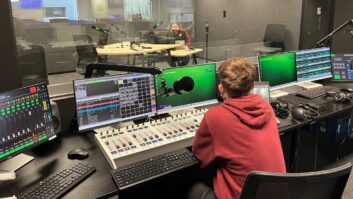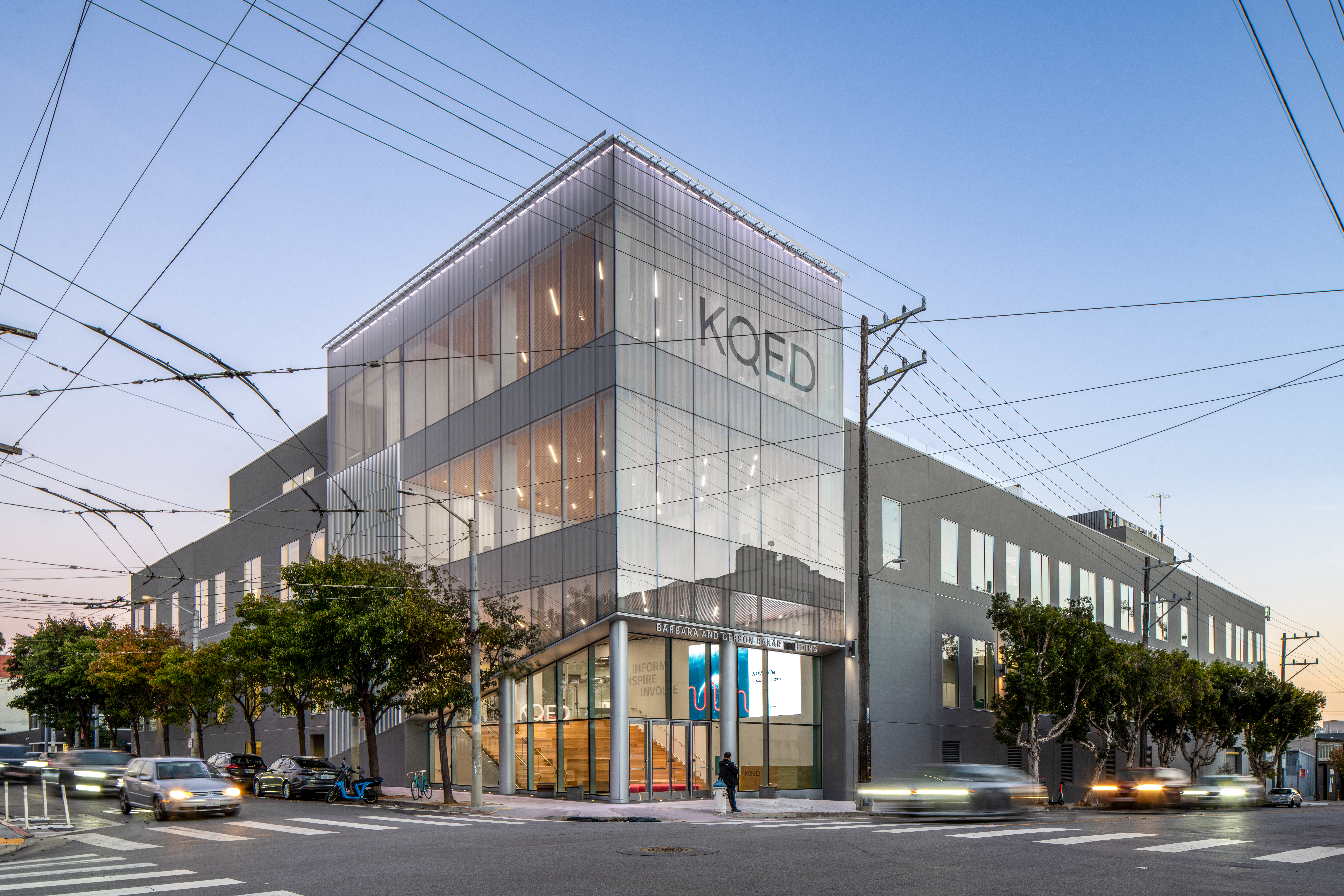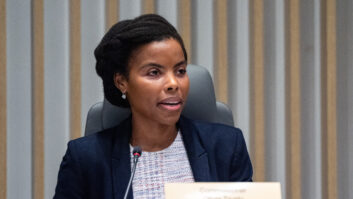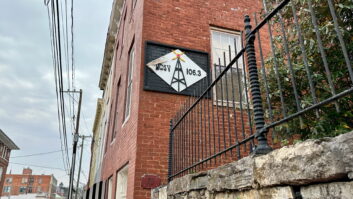There are many things that define a nation: language, customs, traditions. But it is the people of a nation who keep those things alive. It takes patience, perseverance and a strong voice to retain an ancient language and culture in the modern world.
KTNN talk studio and control position. Custom furniture by Ominrax.

For the native people of the Four Corners region of the southwestern United States, that voice is KTNN, �The Voice of the Navajo Nation.� The vision for the future of the station has evolved over time, encountering many obstacles along the way, but now, after more than a decade, that dream has finally become a reality.
KTNN, which is owned by the Navajo People, is not the only radio station broadcasting to the Navajo Nation, but it is the largest. It started in February 1989 as a 50,000 watt directional AM station broadcasting from an old modular building that was the office space for the Navajo government.
The Navajo Nation is a huge land base that extends into three states. KTNN�s powerful AM signal reaches from the tower in Sawmill, Ariz., to Albuquerque, N.M., to Phoenix and to parts of Utah in the daytime. At night, it reaches Canada, with reports of clear reception from Japan and Finland.
From their FM site on Deeza Bluff in Arizona, they also transmit KWRK(FM), 96.1 MHz, a mostly syndicated country format, along with KTNN(FM) at 101.5 FM, a simulcast of KTNN programming.
Space for guests to relax just outside of KTNN studios.

The station is an invaluable resource for the Navajo People, some of whom live in very remote areas with no other access to news and information. KTNN produces all local content, except for the top of the hour news. The majority of the time, the programming is broadcast in the Navajo language, with news and sports in both Navajo and English.
�A lot of things are geared toward our culture,� General Manager Troy Little says.
Some of the programming is seasonal, in accordance with Navajo culture, but he says the focus of the content is to �educate and entertain.� Sunday night programming is all in the Navajo language and includes �sacred stories passed down from our ancestors,� which can only be spoken of in winter, he says. In the spring and summer they talk about other things in the Navajo culture.
As an integral part of the community it serves, the new station had to be not only a technical enhancement, but also an asset that was welcoming to the community.
From concept to completion, the project took 14 years and has gone through many changes.
KTNN acquired the land to build the new station in 2006. When the economy entered the Great Recession, the financial institutions funding the project dropped out as well.
ENTER V THREE STUDIOS
SAS i-SL control surface.

The building went through two prior designs. Little�s predecessor on the board wanted a larger building to allow for leased office space. When Little took over as GM in 2009, he decided to concentrate on the current need, but allow for future expansion. He took the project in a whole different direction, choosing V Three Studios in St Louis to do the design. Once V Three was on board, Little says he knew it was �gonna be a completely different ball game.�
When V Three project lead Josh Hellman took over, there was a design in place but nothing yet existed on site.
�This was a unique project in that it was a clean slate,� Hellman said. His goal was to �create a showcase piece with the design� that had a �good and quick visual connection to the space.�
As part of the design, Hellman said he tries to connect people with what is really going on in that space. For example, someone in the lobby can see into all of the main on-air studios and the equipment room.
From left to right: Troy J. Little (general manager), Oscencio Tom (board of directors member), Don Taylor (president, M. Greenberg Construction), Tina James-Tafoya (board of directors member), Stan Robbins (chair of the board of directors) and Chris Quigley (superintendent, M. Greenberg Construction).

�We try to highlight equipment rack rooms and really bring those to the front,� Hellman said.
There are five racks with space for two more, a cable tray that branches out to clusters of studios directly adjacent to each other, with four main studios on exterior walls with windows and four production studios. This cluster design takes advantage of what Hellman calls the �acoustic envelope.�
Little loves the new design. �It�s a real radio station,� he said.
KTNN broke ground in June 2016 and contracted Greenberg Construction in Gilbert, Ariz., to build the new facility. Hellman says the only real snag was getting local utility companies to get permanent power and infrastructure to the site. They had to have temporary utilities brought in to begin construction. Otherwise, he says, the project went pretty smoothly with �very minimal curveballs.�
Native Innovations, a small network IT company in Flagstaff, Ariz., installed the cable infrastructure. Owner Gerome Tsosie says one of the reasons his company was selected is because of the �Buy Indian First� initiative, which gives first preference to Navajo companies.
Tsosie says his company is �probably the only Native American-owned IT company in the state of Arizona.�
KTNN�s break room provides a bright and comfortable location for staff members to take a meal.

He and his team of five employees pulled 15,000 feet of Cat-6 cable to interconnect the new audio routing system with the new studios and existing equipment. He also installed a 24-port patch panel in each studio to enable patching between the studios and the equipment rack room.
New furniture, by Omnirax, completes the new studios� aesthetics. �It�s beautiful,� Little said, �all the colors, and everything matches.�
Omnirax�s David Holland said, �What made this project unique for Omnirax is that it provided the perfect opportunity to furnish an entire facility.� We worked closely with Kurt Kerns [principal /owner of V Three Studios] on right-sizing the spaces and we�d already designed all the studios by the time we met Troy Little in person at NAB. At that in-person meeting he fell in love with our WeDesk line of office furniture and entrusted us with the task of furnishing all the private offices, conference room and storage needs. We even supplied the chairs throughout the facility.� We understood how important this project was to the Navajo Nation, and we were happy to engage in �collaborative ergonomics� with Kurt, Troy and SAS to help realize Troy�s dream, and along the way make both his furniture and seating headaches go away.�
The station also erected a new Rohn 45GSR 40-foot tower at the site to hold two new Marti SC48 4-foot STL antennas.
COMBINING NEW AND OLD
The KTNN facility as seen looking west. Architecture by V Three Studios of St. Louis; built by Greenberg Construction of Gilbert, Ariz.

In the studios, Little replaced the existing system from the old facility with a new SAS system. �We needed to get updated on a lot of things,� he said.
Little and Audio Director Nathan Chester chose SAS because they said it was more flexible than other options. The legacy gear they needed to integrate into the new system was analog, and they required a system that would allow them to continue to use some old equipment, with the ability to update to newer technologies in the future. SAS Vice President Al Salci then designed a system to fit KTNN�s needs.
It uses a 512 I/O 32KD frame in the equipment room with modules to interconnect with the engines in the studios and with existing gear in the equipment room. There are four RIO DSP engines, each with two paired audio consoles. The KTNN control room and talk studio are paired on one RIO. The KWRK control room and news studio are paired on another. The production studios are paired two each to the third and fourth engines.� All signaling between the RIOs and the 32KD frame is done via 100baseT cabling. The analog audio inputs and outputs are converted to RJ45 by SAS dongles. The system is AVB-compatible � the studio RIOs can support AoIP devices.� Analog modules can be swapped with digital modules on future upgrades.
Salci says the advantage to his multichannel, multi-bus system is the discrete DSP engine architecture, which eliminates the issue of a single point of failure and reduces data flow through the main frame, since processing is done in the individual engines.
Chester configured, connected and tested the SAS system. He has a degree in audio production but had never configured a system before. �It took a lot of trust from Troy as a general manager to let me do the configuration,� he said. He says it was �mostly easy,� with not too many issues.
SAS system design for the KTNN facility, showing locations of i-SL, Rubi-T and M-Class control surfaces.

Chester spent a lot of time reading the manual and relied on SAS to answer all of his questions. They also did remote dial-in sessions to help with the configuration. He was impressed that Salci answered most of his questions.
Operationally, he couldn�t be happier. �It just works! Can�t beat that,� he says.
And Chester is glad Little gave him the opportunity to configure the new system because the knowledge he gained will enable him to train his nine operators.
If he had it to do again, he said, �I would sit down with SAS and map it out� � after that �it was a piece of cake.�
In accordance with Navajo cultural tradition, a shaman performed a ceremony to bless the building before KTNN moved in.
Left to right: Tim Lewis of M. Greenberg Construction, GM Troy Little, acting lead on-air talent Dee Yazzie, Music Director Nate Chester and Promotions Coordinator Marcia Peshlakai.

The station went live on March 7. Chester says they expected to be off the air for a day or two while they made the transition, but instead, they switched over live during a boys� basketball game with no interruption. �We just flipped one switch to another switch,� Little said.
The new system is a noticeable improvement. �It sounds a lot better, clear, beautiful,� Little continued. �I think this is a really good asset for the Navajo Nation.� I think the community will love it. It�s their radio station.�
The grand opening on March 29 was met with great enthusiasm from the community. More than 1,000 people attended the event at lunchtime and more than 500 showed up that evening for an unplanned celebration that featured a group of native dancers.
At the end of a journey that spanned more than a decade, the vision has finally materialized. The man who was entrusted to bring that vision to life looks beyond the struggles, preferring to focus on the positive. �I have learned patience,� Little says. �Having to wait has been a blessing.�
Judy Bandstra has been a broadcast engineer for nearly 20 years, the last two with Colorado Public Radio. Prior to that, she spent seven years in the U.S. Navy as an RF technician.







